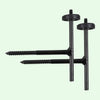Outdoor security cameras review

An outside security camera can serve as a strong deterrent to would-be criminals. It will tell you if the bump in the night is caused by a friend, adversary, or a furry critter.
Outdoor security cameras: What do they do?
Most smart outdoor security cameras link to your home network by a Wi-Fi radio, allowing you to view them via a mobile app from anywhere. However, some versions may link to a mobile app or a specialized hub through wired Ethernet, Bluetooth, Z-Wave, or unique wireless technology.

Which Weather Conditions Can Outdoor Security Cameras Handle?
Any outdoor camera worth its salt should have an IP (Ingress Protection) rating to ensure it can endure the environment. The IP rating comprises two numbers that indicate how well the camera will withstand typical weather conditions. The first digit after the IP prefix indicates how resistant the camera is to solid item ingress, such as wind-blown dust, and ranges from 0 (no protection) to 6 (complete protection) (total protection against dust and dirt). The second number, which goes from 0 (no protection) to 9, indicates how resistant the camera is to moisture (protected against close-range, high-pressure spray downs from all angles).
Are you looking for a resolution?
If you can't see who or what the camera is seeing, it's meaningless to have an external security camera. When it comes to video, 1080p is the most popular resolution for these cameras since it gives more information and is sharper. It takes less space and can be viewed on almost all mobile devices, tablets, and desktop computers.
4K (Ultra HD) cameras are also available. Still, you'll need a very powerful network connection to stream it without choppy or lag, and you'll need a lot of storage space to save recorded footage, which might result in high cloud storage costs.

Is Motion and Sound Detection Necessary?
Nearly all outdoor security cameras have a motion sensor that triggers the camera to record footage when motion is detected. When activity is detected, the sensor can send a push notification to your phone, and some can also send an email alert. Look for a camera with sound detection to let you know if someone is around, even if they're out of range of the camera lens and motion sensor. To eliminate warnings from barking dogs, loud automobiles, and other unexpected noises, you'll need to adjust the sound sensitivity settings.
Suppose the camera includes a microphone for sound detection. In that case, it very certainly also has a speaker and two-way audio communication, allowing you to communicate with (and listen to) whoever is outside. This is useful for dealing with obnoxious solicitors and may also frighten away porch pirates and other undesirable guests.
How are security cameras storing video?
There are several options for storing recorded video. Many cameras provide free cloud storage for a short time (usually seven days) before being overwritten or removed, while others need a subscription. You may subscribe to a 30-day plan if you need more than a week's worth of video storage and don't want to worry about losing essential film before you've had a chance to analyze and download it.
If you're concerned about privacy and don't want your video stored on the cloud, opt for a camera that has a microSD card port so you can save it locally. Only a few cameras allow you to store footage to a USB or NAS storage, but these devices are few and far between.
Search for a camera that includes a CVR plan, which means that camera will record constantly and save up to 30 days of video in a cloud-based storage service like Dropbox or Google Drive.

















Leave a comment